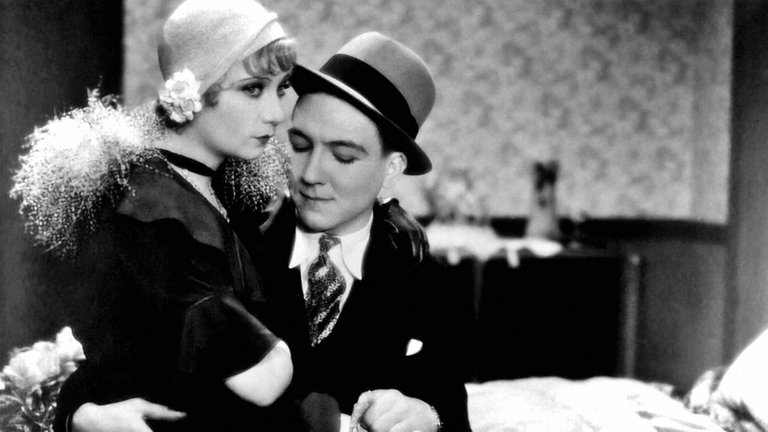
Films on foreign markets are, as a rule, distributed under translated title. When the title isn’t translated it is usually for a good reason. That thing happened to La Chienne, 1931 French film directed by Jean Renoir, which was shown in English-speaking countries under original title. It had something to do with title literally meaning “The Bitch”, which would probably create too much unnecessary problems with censorship.
The film is based on the eponymous 1929 crime novel by Georges de la Fouchardière. After a prologue, in which Grand Guignol puppets explain the audience that they are going to see a story “without heroes or villains” and about “ordinary people like you and me”, plot begins in famous Parisian neighbourhood of Montmartre. Main character is Maurice Legrand (played by Michel Simon), middle-aged cashier in hosier company. He is unhappily married to Adèle (played by Magdeleine Bérubet), woman who mocks and abuses him. The only thing Maurice lives for is his painting. One night, while returning home from the office party, he sees young woman named Lucienne “Lulu” Pelletier (played by Janie Marèse) being attacked by a street thug. He comes to her rescue, pays for her taxi, escorts her home, falls hopelessly in love with her and she apparently returns his feelings. What Maurice doesn’t know is that Lulu is actually a prostitute and the thug who attacked her is actually her pimp and boyfriend André “Dédé” Joguin (played by Georges Flamant). Maurice keeps financially supporting his young mistress, and when the funds dry up he even embezzles funds from his employers. In the meantime, Dédé tries to sell some of Maurice’s paintings and discovers that they are much appreciated by art critics and dealers. He passes Maurice’s paintings as Lulu’s until Maurice discovers charade with violent and tragic consequences.
Jean Renoir, son of famous Impressionist painter Pierre-Auguste Renoir, was already established name in French cinema thanks to his 1920s silent films. La Chienne, which represented his second sound film, can be interpreted as the work that adheres to Author Theory that would become fashionable few decades later. It is very personal film for Renoir, being set in artistic milieu and Montmartre, where he actually lived. Renoir also showed great talent in bridging the limits of early sound technology. Instead in studio, La Chienne was actually shot on Parisian streets, but in strictly technical terms doesn’t look or sound differently than films that would come later. Like with many classics from the early sound era, there is almost no music in La Chienne, except during the scene featuring street performers near the end. But, the audience wouldn’t care that much, being engrossed in the story which is simple yet fascinating with its strange blend of tragedy, keen social observation and dark humour. What would many other film makers turn into strictly “pulp” story about man falling for the wrong woman Renoir took as an opportunity to express his strong left-wing beliefs and attack hypocrisy and falsehoods of the class-based bourgeoisie society. Two of the characters that become ultimate victims are those who aspire either to material wealth or mingling with “polite society”, while the one that does not at the end ironically finds happiness by discarding last traces of his middle class existence and enjoying life as a street bum unburdened with society’s obligations.
Renoir had very good cast at his disposal. Most notable is Michel Simon, eccentric Swiss actor who would later become one of the great icons of 1930s French cinema, known for bohemian lifestyle. The casting, on the other hand, created a lot of off screen drama. Renoir lost his wife Catherine Hessling after agreeing to studio suggestions to cast young actress Janie Marèse in the role of Lulu instead of her. On the set actors’ romantic life represented carbon copy of their characters. Michel Simon fell in love with Marèse who, just like her character, fell in love with Georges Flamant. Renoir actually encouraged those developments, hoping to extract best performances from his actors. In the end it led to tragedy. Shortly after premiere Flamant was driving Marèse in his new car on French Riviera. As an inexperienced driver, he crashed. He survived, but Marèse didn’t. He was branded “murderer” by French media and negative publicity has affected the rest of Flamant’s career. Renoir’s reputation, on the other hand, didn’t suffer and La Chienne actually became international hit. In 1945 Fritz Lang directed Hollywood remake under title Scarlet Street, which is, despite “bowdlerising” much of the original content in line with Hays Code, considered one of film noir classics.
RATING: 8/10 (+++)
Blog in Croatian https://draxblog.com
Blog in English https://draxreview.wordpress.com/
Leofinance blog https://leofinance.io/@drax.leo
Unstoppable Domains: https://unstoppabledomains.com/?ref=3fc23fc42c1b417
Hiveonboard: https://hiveonboard.com?ref=drax
Bitcoin Lightning HIVE donations: https://v4v.app/v1/lnurlp/qrcode/drax
Rising Star game: https://www.risingstargame.com?referrer=drax
1Inch: https://1inch.exchange/#/r/0x83823d8CCB74F828148258BB4457642124b1328e
BTC donations: 1EWxiMiP6iiG9rger3NuUSd6HByaxQWafG
ETH donations: 0xB305F144323b99e6f8b1d66f5D7DE78B498C32A7

Congratulations @drax! You have completed the following achievement on the Hive blockchain And have been rewarded with New badge(s)
You can view your badges on your board and compare yourself to others in the Ranking
If you no longer want to receive notifications, reply to this comment with the word
STOPCheck out our last posts: